Idaho has a varied landscape that includes forests, mountains, rivers, farmlands, and marshes. No wonder so many creatures and flora call this state home! In addition to the native flora and fauna that live here, many invasive species in Idaho negatively affect this environment. From mammals, birds, fish, and insects, to plants, the fight against invasive species continues even today.
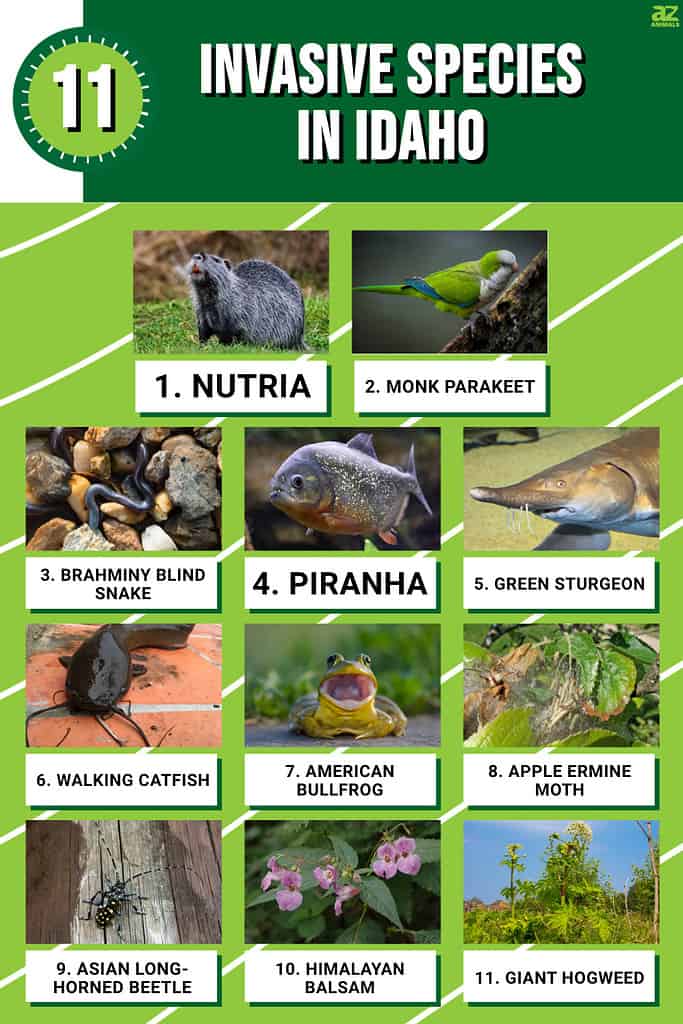
Here are some of the invasive species you can find in Idaho.
1. Nutria (Myocastor coypus)
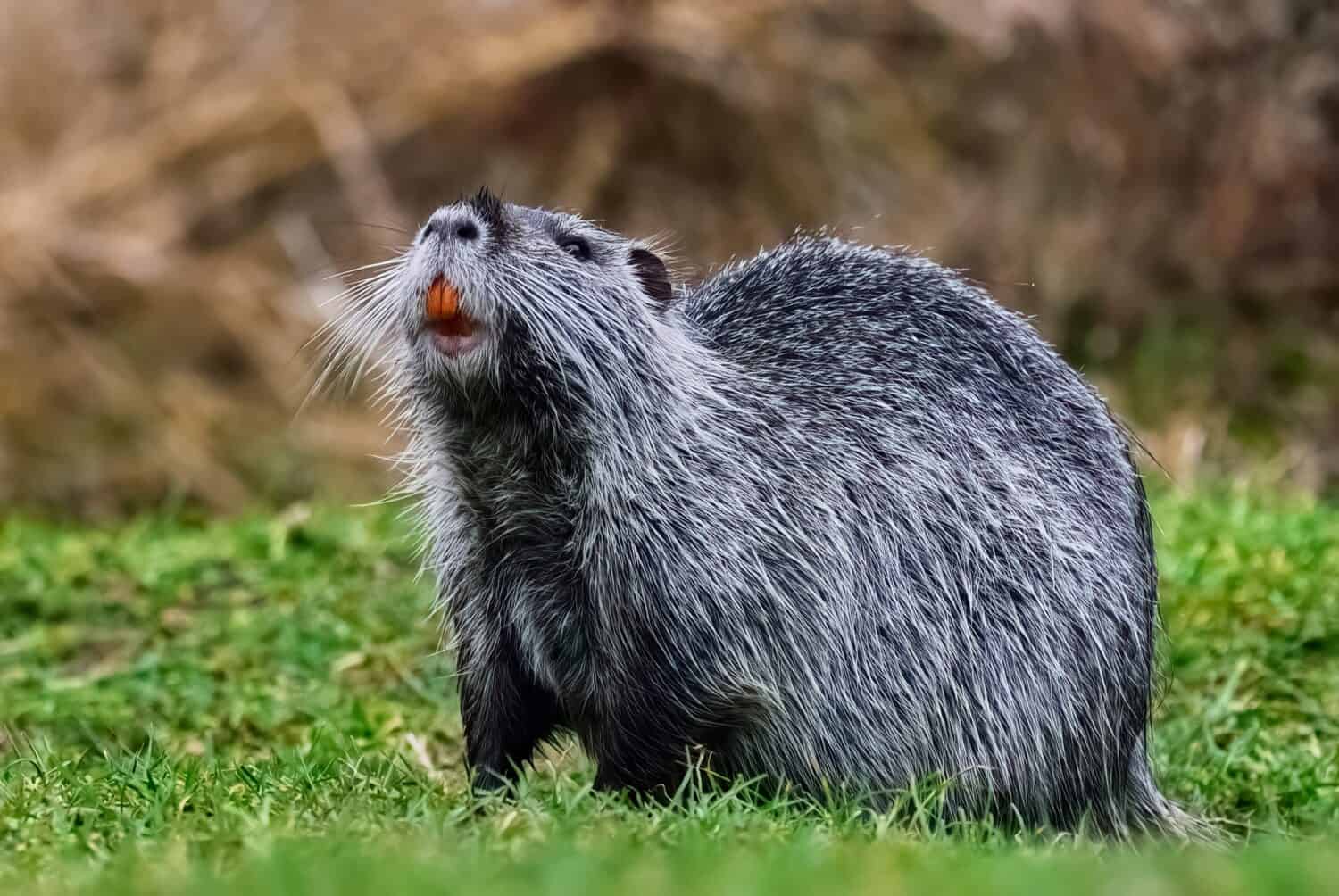
Hailing from South America, the nutria is an invasive species in Idaho.
©Robert Adami/Shutterstock.com
The nutria is a large rodent from South America and has made its way to Idaho. Most parts of the United States, including Idaho, now consider them to be invasive. Nutrias can grow between 17 to 25 inches long and weigh around 15 to 22 pounds. They also have thick, dark fur and have a distinctive white patch around their mouths.
Nutrias are herbivores and will mostly eat the aquatic vegetation they find around their habitats. They feed on the roots, leaves, and stems of most plants.
These rodents are invasive in Idaho due to their feeding habits. They can cause damage to plant life, resulting in the degradation of wetlands and erosion of riverbanks and lakes. In addition to this, they can reproduce at a rapid rate. They give birth to around 13 young per litter and several litters per year. With this reproduction rate, they compete with native species for both food and habitat space.
Idaho has several control methods in place to reduce the population of these invasive animals. These methods include trapping, installing barriers to protect certain areas, and raising public awareness to report sightings of the nutria.
2. Monk Parakeet (Myiopsitta monachus)

The monk parakeet has a gray forehead and crown, which gives it its name.
©Roel van Moorsel/Shutterstock.com
Also coming from South America, the monk parakeet was introduced to Idaho and most of the United States due to their popularity as pets. They are medium-sized parrots and weigh between 3.5 and 5.3 ounces. They grow to be around 12 inches long from beak to tail. These birds get their name due to their grey forehead and crown, which resembles the look of a monk. They have green feathers, a grey throat, and a long tail.
The monk parakeet’s diet includes various plants, insects, grasses, and seeds. In captivity, they will also eat fruits and nuts.
One of the reasons these birds are invasive to Idaho is their ability to form large groups and communal nests in urban areas. Their nests are usually constructed atop utility poles or buildings, which can cause damage to the infrastructure and the potential to start fires. In addition, monk parakeets can outcompete native species for food and resources, disrupting the local ecosystem.
Methods to control the spread and population growth of these birds include nest removal, nest destruction, and trapping of live animals. Local authorities, utility companies, and wildlife agencies also take action to reduce the negative aspects these birds bring, especially to infrastructure.
3. Brahminy Blind Snake (Indotyphlops braminus)
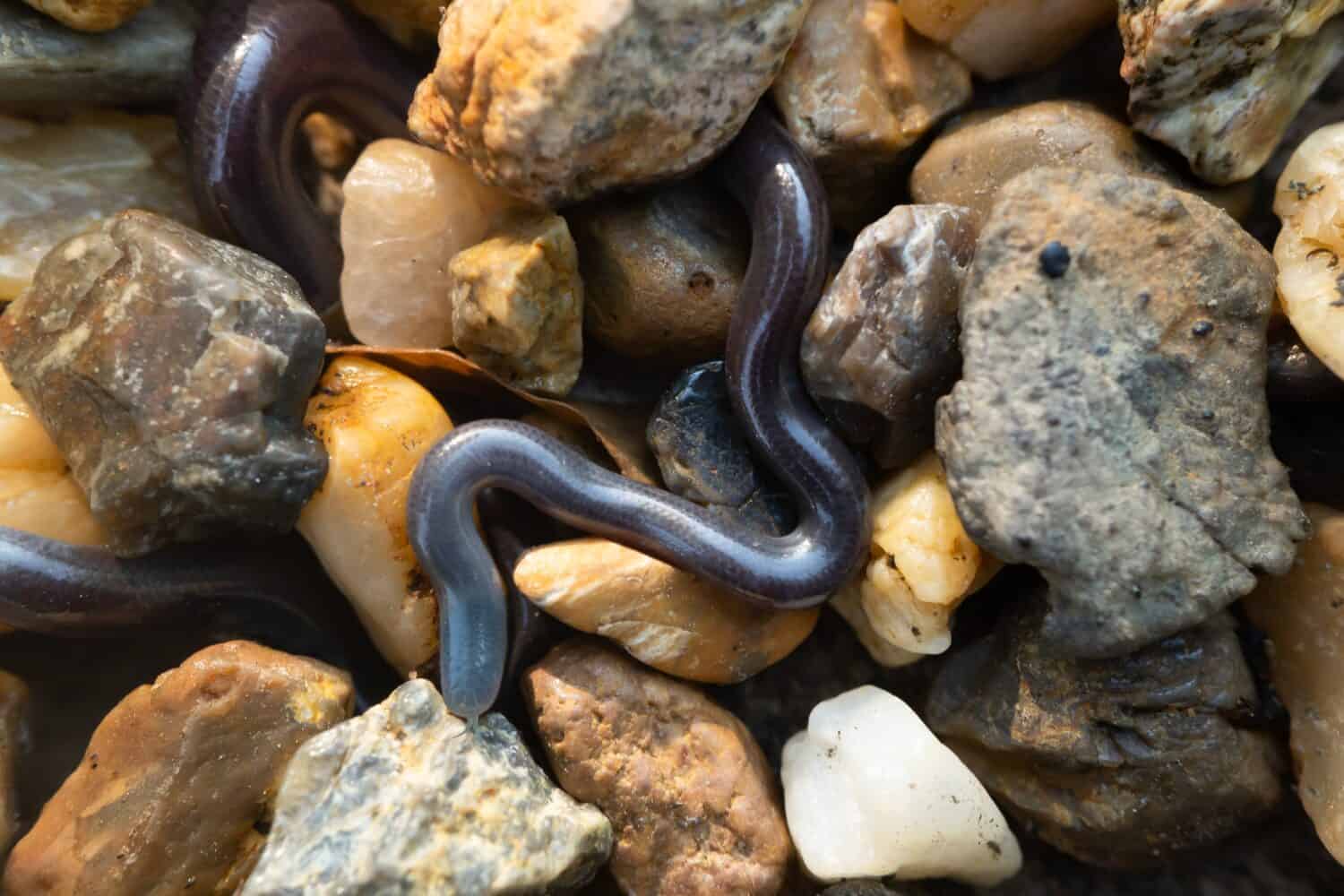
Although not venomous, the Brahminy blind snake is a nuisance to humans.
©frank60/Shutterstock.com
The Brahminy blind snake is native to South Asia but is now found in other parts of the world, including the United States. This species of blind snake is small and grows to around 4.5 to 6.5 inches long. They can be shiny grey, charcoal grey, or purple in color on their back, and they have a gray to brown abdomen. Furthermore, the tail has a pointed spur, and the scales are small, smooth, and shiny. As the name suggests, these blindsnakes are blind and only use their eyes to register the intensity of light.
The Brahminy blind snake is found in the soil and can easily be mistaken for earthworms. These snakes are not hunters and will only feed on insects they encounter. The diet of the Brahminy blind snake includes insect eggs, larvae, termites, earthworms, caterpillars, crickets, and fungi.
Although the Brahminy blind snake is not venomous, these creatures can release a foul smell when threatened and use their pointed tail to attack. Unfortunately, chemical control measures are not recommended for blind snakes. Luckily, the Brahminy blind snake does not threaten native flora or fauna. However, the population of the Brahminy blind snake is expanding, and humans do not like to have them inside their homes. One way to keep these wriggly creatures out of your home is to remove surface items or debris near your house where they can hide.
4. Piranha (Serrasalmidae)
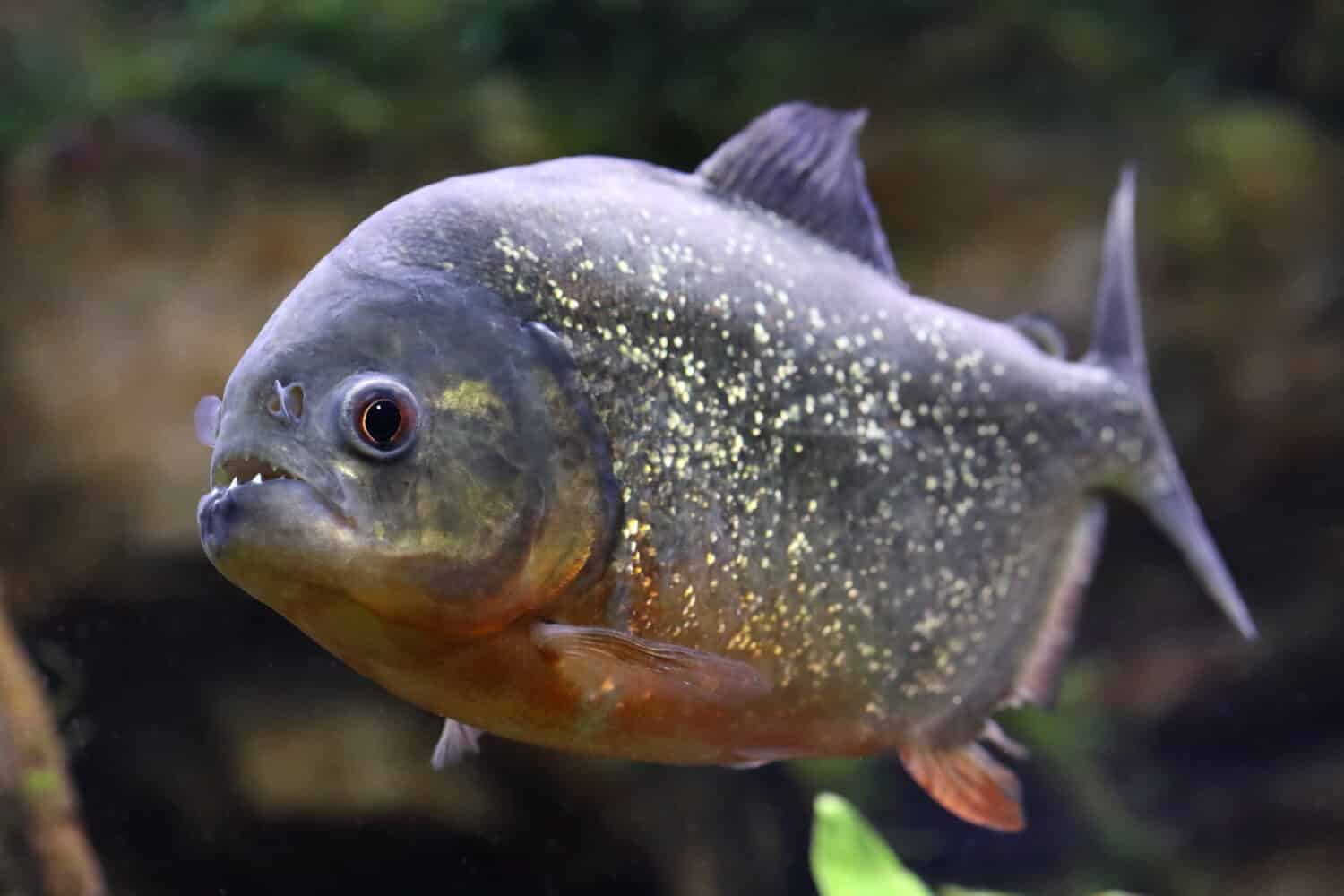
Native to South America, the piranha is a risk to native wildlife in Idaho.
©Grigorii Pisotsckii/Shutterstock.com
Piranhas are native to South American rivers and lakes and are most commonly found in Brazil, Venezuela, and Argentina. Although they have not been officially found in Idaho, the state still classifies them as invasive and prohibits the sale or purchase of live fish. Piranhas are small fish that boast a set of extremely powerful jaws. Their teeth are razor sharp and, when combined with their jaw strength, they make for lethal hunting tools against their prey. They have silver-greyish colored bodies and can grow up to 12 inches in length and up to 2 pounds in weight, with some outliers reaching over 7 pounds!
Piranhas are carnivorous fish that eat anything from other fish, crustaceans, insects, or even birds and small mammals that come too close to their waters.
Because of the severe risk to native wildlife in Idaho, strict measures are in place to ensure these aggressive fish do not become introduced. It is illegal to buy or sell piranhas in the state, and potential owners require a special permit to keep them as pets. Other control methods are also in place to ensure public knowledge of the dangers that come with them.
5. Green Sturgeon (Acipenser medirostris)
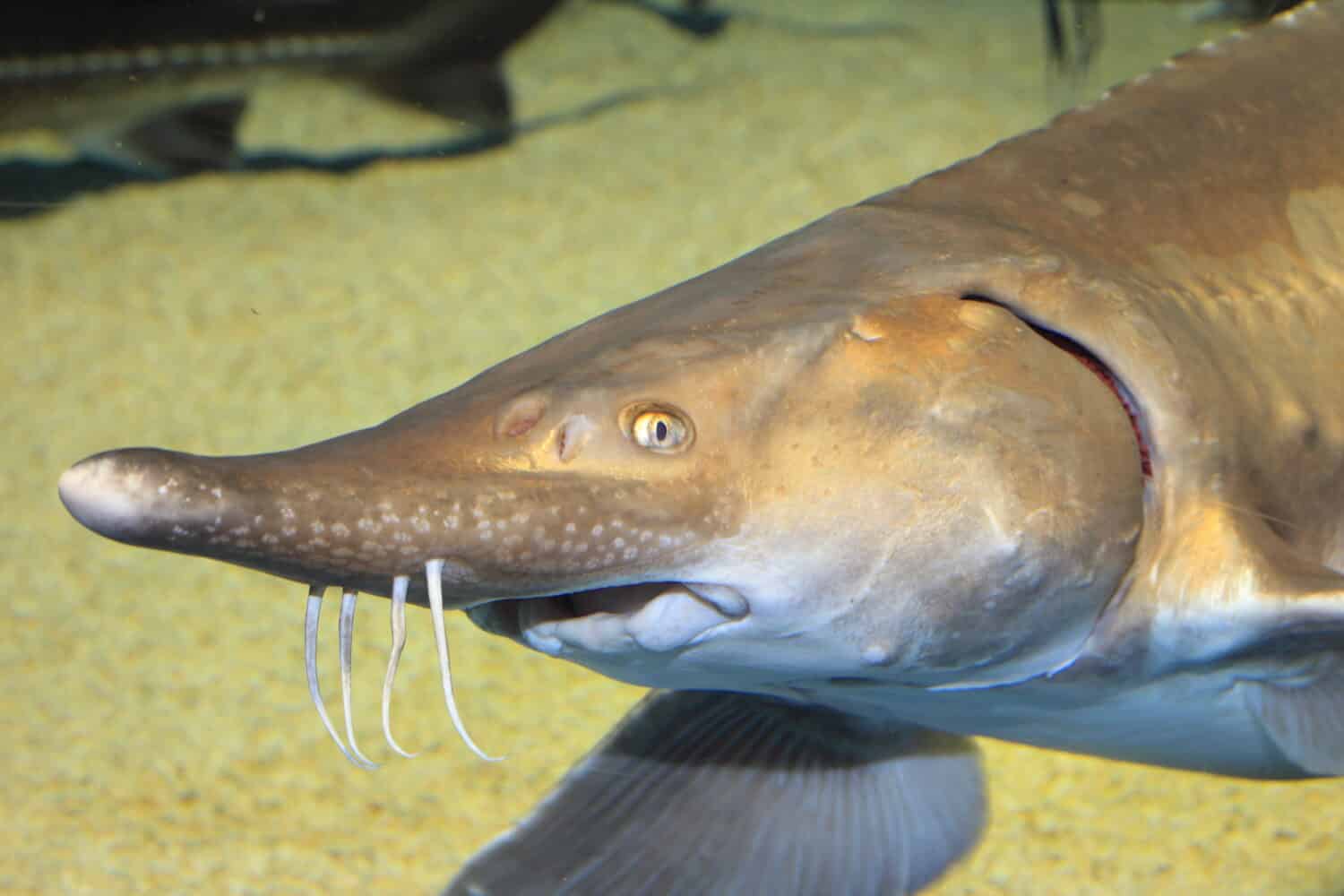
Competing for resources with native fish, the green sturgeon is an invasive fish in Idaho.
©feathercollector/Shutterstock.com
The green sturgeon is a fish native to the eastern Pacific Ocean. While other species of sturgeon roam Idaho’s waterways, the green sturgeon has not yet been found in the state. Regardless, the fish is still listed as invasive by the U.S. Fish and Wildlife Service due to the harm it could cause. Green sturgeons are large salt and freshwater fish with long slender bodies and shark-like tails. Their skin is light to dark green and has a very rough, bony texture. When fully grown, they can reach lengths of up to 7 feet and weigh upwards of 350 pounds.
The diet of the green sturgeon consists mostly of worms, crustaceans, mollusks, and other smaller fish. They use their barbels at the end of their snouts to detect their prey hiding in the sediment.
In areas where they have been found, the green sturgeon competes for resources from other fish, mostly salmon and steelhead. This leads to a decline in these fish populations. Green sturgeon are constantly under research in Idaho to better learn about their behavior and risks of potential introductions into the state’s waters.
6. Walking Catfish (Clarias batrachus)
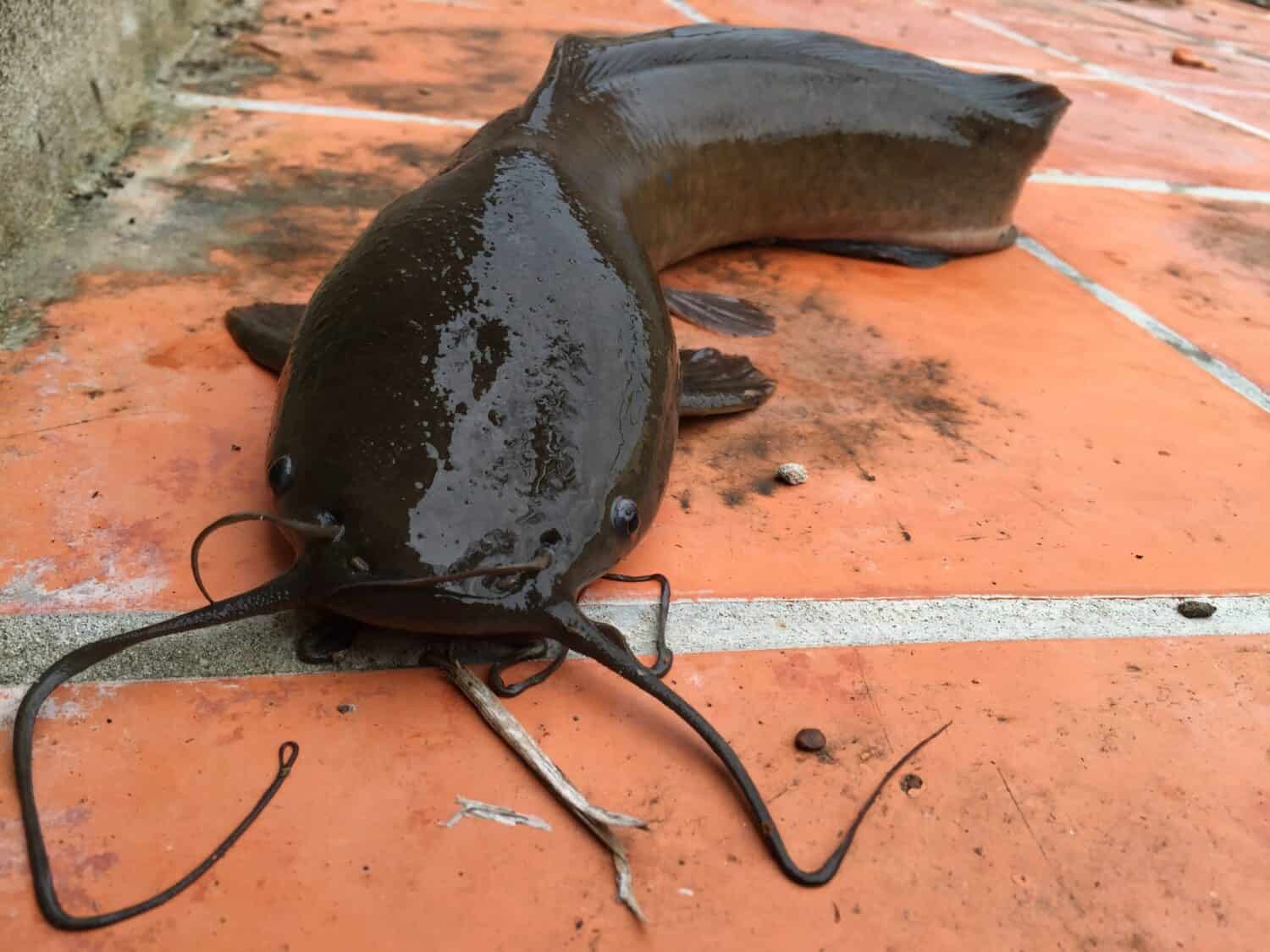
Opportunistic feeders, walking
catfish
will eat everything, competing with native species for food.
©Trieu Tuan/Shutterstock.com
Walking catfish are native to Southeast Asia and have been found around the world, including Idaho, most likely due to accidental introduction. These freshwater fish have long bodies and flat heads with several pairs of long barbels protruding from their mouths. They are usually dark-colored with a lighter underside. They can grow up to 20 inches long and weigh up to 3 pounds.
Walking catfish are opportunistic feeders and will eat a variety of things, such as insects, aquatic plants, or anything drifting through the water.
Walking catfish are considered invasive throughout Idaho due to the risk they pose to native species. These fish compete with native species for food and habitat and prey on them. This can cause a decline in native fish populations and damage to the local ecosystem.
The removal and trapping of walking catfish are effective methods of controlling their populations, as well as the use of chemicals to deter them from specific areas. Another method is raising awareness of these invasive fish and informing the public of the best ways to avoid furthering their spread.
7. American Bullfrog (Lithobates catesbeianus)
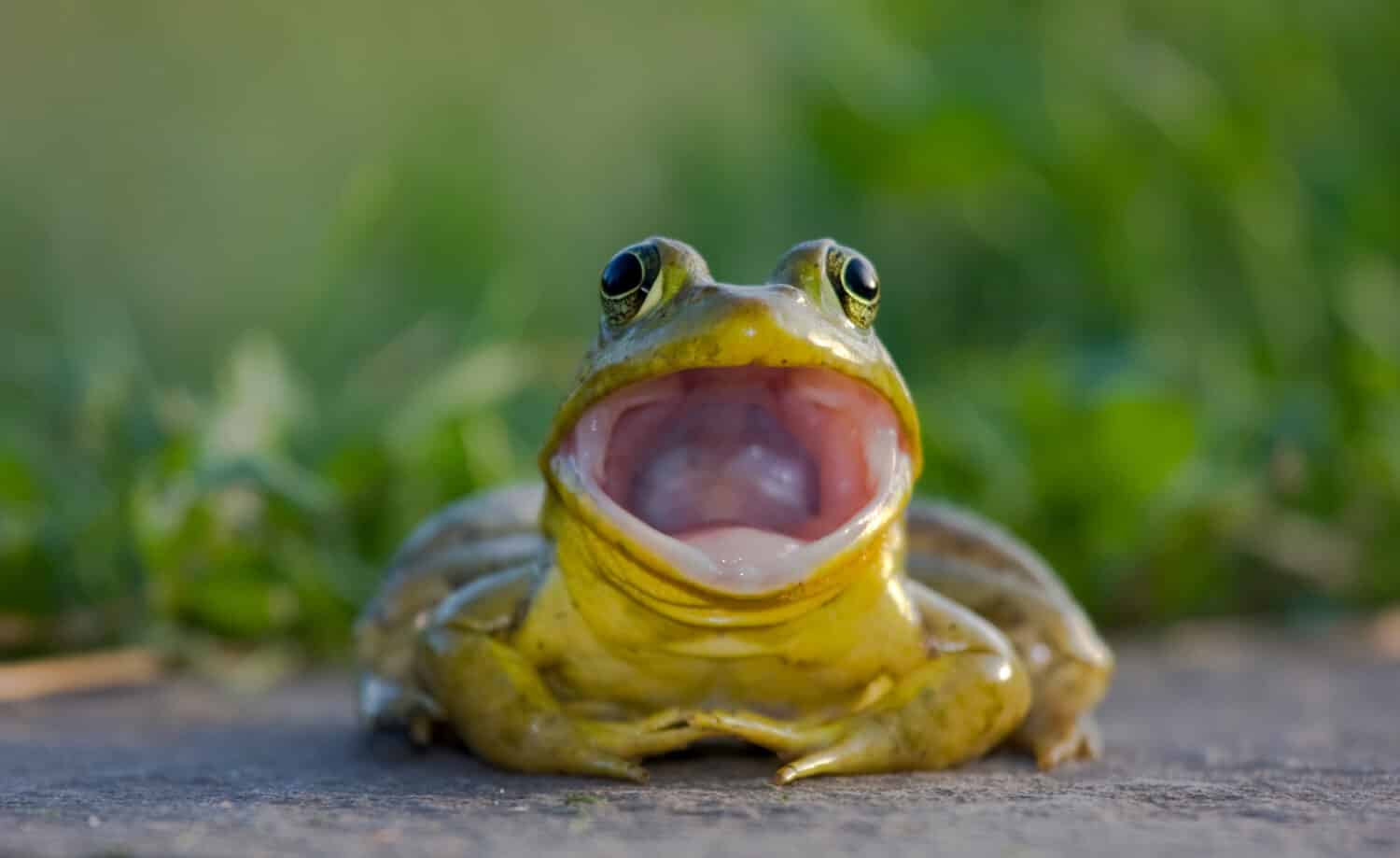
The largest frog species in the region, the American bullfrog is not native to Idaho.
©Tau5/Shutterstock.com
The American bullfrog is native to eastern parts of North America. It is considered one of the largest frog species in the region. The population of the American bullfrog has since flourished and spread to other parts of the country, including Idaho. This amphibian can grow from 3.5 to 6 inches in length and can weigh from 0.5 to 1.5 pounds. The skin is smooth and is olive-green or brownish-green in color. Finally, the back of the frog is blotched with dark patches, while the abdomen is white.
The American bullfrog’s diet consists of insects, worms, spiders, small fish, and other amphibians. The bullfrog’s diet is one reason it is considered invasive. Unfortunately, they have a voracious appetite that harms native populations by outcompeting native species for food and habitat. Not only that, these frogs produce large numbers of eggs which rapidly increases the bullfrog population.
Control methods for the American bullfrog include removal programs, monitoring of the species, and raising public awareness. These methods will reduce the negative impact these frogs have on the native environment.
8. Apple Ermine Moth (Yponomeuta malinellus)
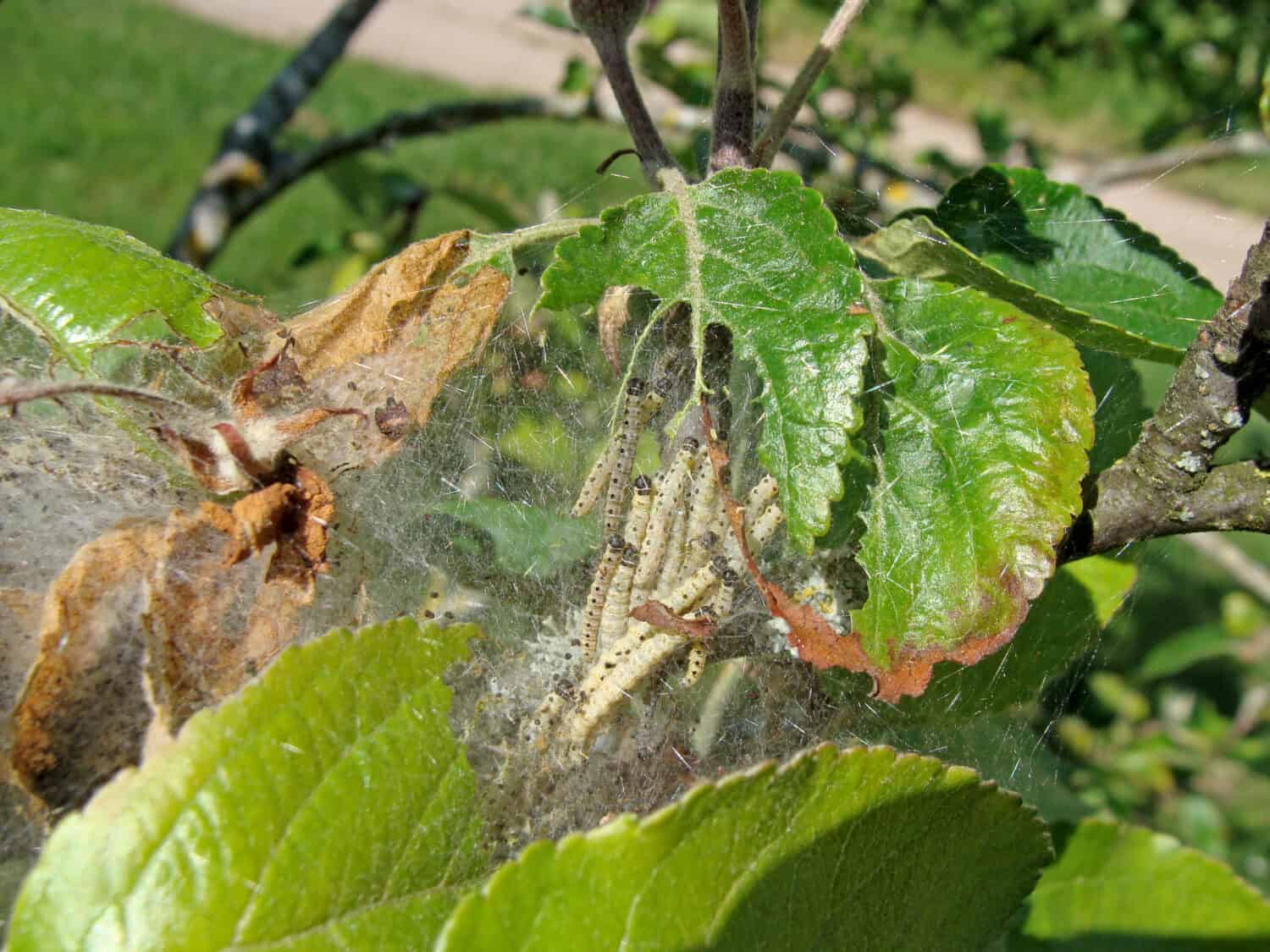
The larvae of the apple ermine moth will eat the flowers and leaves of apple trees.
©Grandpa/Shutterstock.com
Apple ermine moths are native to Europe and have spread to North America, including Idaho. They were discovered in the state in the mid-2000s, where they were most likely introduced in imports of infested fruits. These moths are white with small black dots on their wings and can grow between 0.8 to 1.2 inches long.
The apple ermine moth’s diet consists of various fruits, but it prefers apples, giving them its name. The larvae will also eat the fruit trees themselves, feasting on the flowers and leaves of the tree.
Apple ermine moths are considered invasive in Idaho due to the nature of their feeding. They cause damage to the fruits and foliage of the host tree, resulting in a lesser yield, and can cause enough damage to kill the tree completely. These moths can reproduce and spread rapidly and quickly overrun entire orchards of fruit trees.
The state has several control methods in place to remove this nuisance insect. These methods include the removal of the moths when they are discovered, the removal of entire branches of the infested trees, and the use of targeted insecticides to kill off entire populations.
9. Asian Long-Horned Beetle (Anoplophora glabripennis)
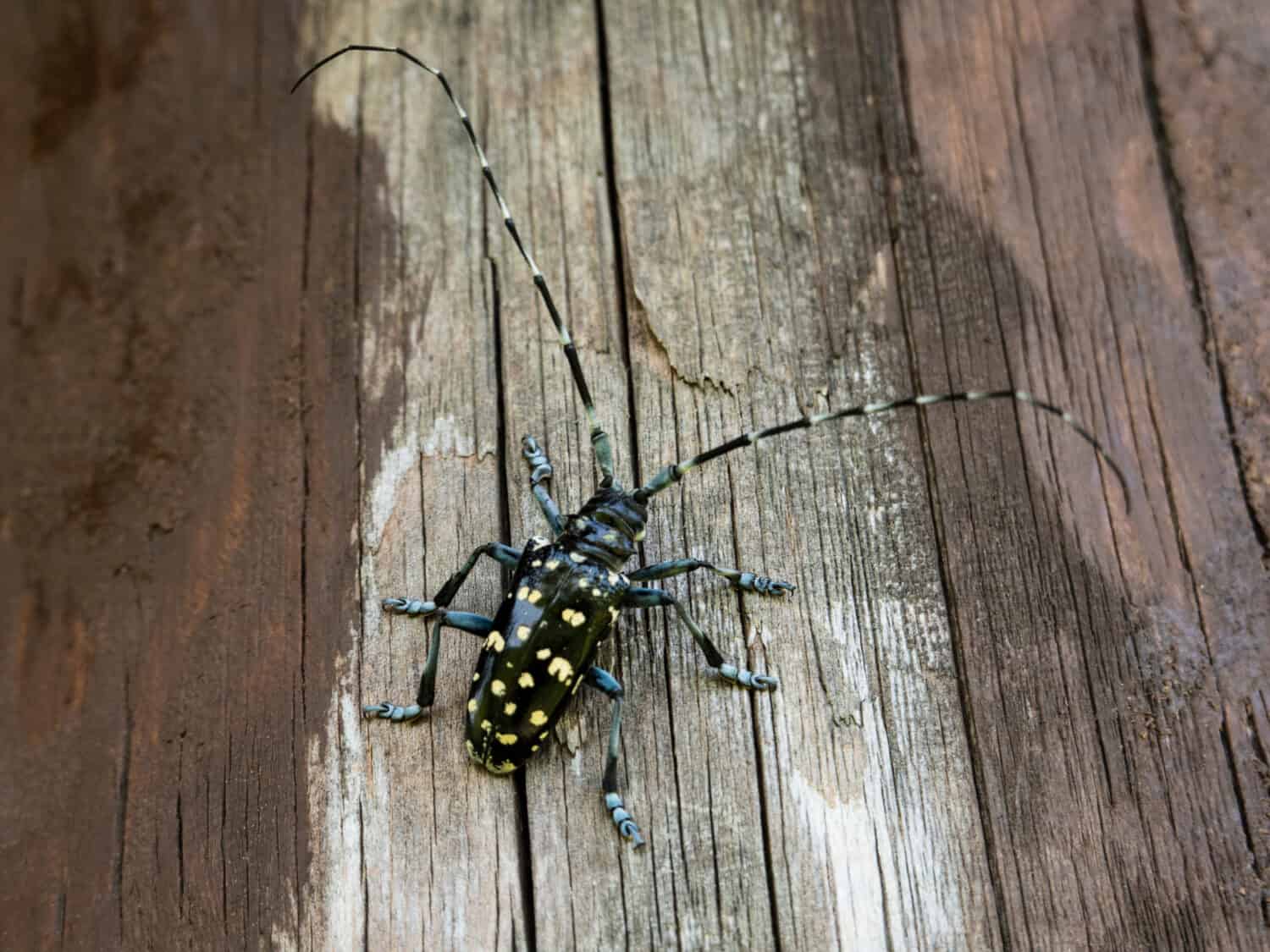
Considered one of the most invasive beetles in the world, the Asian long-horned beetle can cause tree mortality.
©letspicsit/Shutterstock.com
The Asian long-horned beetle originated from Eastern Asia. These beetles are considered one of the most invasive beetle species in the world. They are also commonly known as sky beetle or starry sky. These insects are easily identifiable as they have striking features. They have shiny, hark, black exoskeletons that are black in color. They have 20 white spots on their wings. These beetles are quite large and range from 0.6 inches to 1.55 inches in length. Their antennae are long and can be around 1.6 inches in length.
The Asian long-horned beetle is found on leaves and the bark of trees such as maples, willows, and elms. They are herbivores and feed on trees, bark, and other plant matter. These insects are considered invasive because of their impact on the trees they inhabit. The issue comes from larval feeding, which can cause tree mortality and change forest and urban ecosystems. Not only do they harm the trees, but these beetles also cause significant economic loss. In the United States, these beetles have the potential to destroy around 30% of urban trees, resulting in an economic loss of $669 billion.
Control measures for the Asian long-horned beetle are necessary and include measures such as monitoring, quarantine, biological control, and even romal of infested trees. These beetles are not known to occur in Idaho yet, but due to the damage these beetles can cause, they are prohibited in the state. If you come across one of these invasive insects, make sure you report it! Early detection is the best way to stop a full-scale infestation.
10. Himalayan Balsam (Impatiens glandulifera)
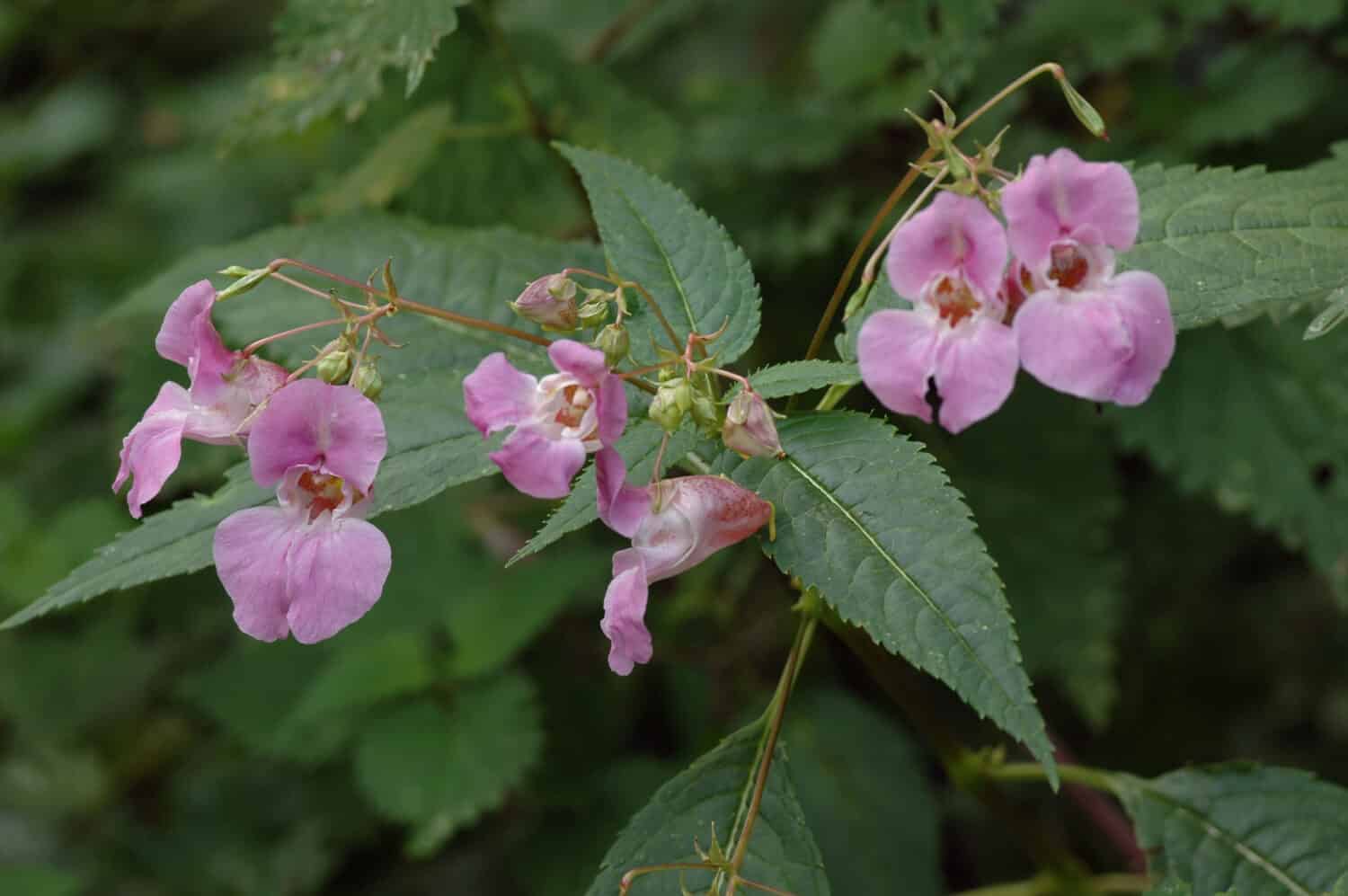
With seed pods that explode when touched, the
Himalayan
balsam can disperse the seeds several feet.
©Martin Fowler/Shutterstock.com
Also called Policeman’s Helmet, Himalayan balsam is a “touch-me-not” plant native to the Western Himalayas. It is a tall plant with spiked leaves that grow in opposite pairs along the stem. It features bright pink or purple annual flowers and produces sweet-smelling nectar at the base of each leaf. The plant is tall, growing up to 10 feet, and has hollow stems similar to bamboo.
Himalayan balsam is invasive in Idaho due to its ability to spread rapidly. The plant grows seed pods that explode when touched, dispersing the seeds several feet in all directions. Combining this feature with the plant’s rapid growth rate means it is tough to prevent the spread of the plant. It grows in dense patches which can take over habitat from native plant populations.
Removal of established and new growth of Himalayan balsam is the most effective control method used, especially before they go to seed. Another method of control used in Idaho is the introduction of insects that feed specifically on Himalayan balsam.
11. Giant Hogweed (Heracleum mantegazzianum)

A noxious weed, giant hogweed can cause blistering, scarring, burns, and even blindness.
©svetlana-81/Shutterstock.com
Giant hogweed is a large herbaceous plant from Eurasia. As the name suggests, this plant is huge and can grow from 6 ft 7 inches to 18 ft 1 inch if grown in ideal conditions. Furthermore, the leaves are large and lobed and grow between 3 ft 3 inches to 4 ft 11 inches in width! The flowers of the giant hogweed are white, while the stem is bright green. The stem also has coarse white hair with dark splotches.
The giant hogweed is a noxious weed because the sap is phototoxic and can cause photodermatitis. Not only can the plant cause blistering and scarring, but some can also cause severe burns! The sap can also cause temporary or permanent blindness if it comes in contact with the eyes. So, be careful when you encounter this plant!
There are several control measures for the giant hogweed. The most effective control method is root cutting. Herbicides can also be effectively used as a control method. Other measures include flower head/seed head removal, cutting, and mowing.
Summary of 11 Invasive Species in Idaho
| Species | Origin | |
|---|---|---|
| 1 | Nutria | South America |
| 2 | Monk Parakeet | South America |
| 3 | Brahminy Blind Snake | South Asia |
| 4 | Piranha | South America |
| 5 | Green Sturgeon | Eastern Pacific Ocean |
| 6 | Walking Catfish | Southeast Asia |
| 7 | American Bullfrog | North America |
| 8 | Apple Ermine Moth | Europe |
| 9 | Asian Long-Horned Beetle | Eastern Asia |
| 10 | Himalayan Balsam | Western Himalayas |
| 11 | Giant Hogweed | Eurasia |
The photo featured at the top of this post is © Tau5/Shutterstock.com
Thank you for reading! Have some feedback for us? Contact the AZ Animals editorial team.







